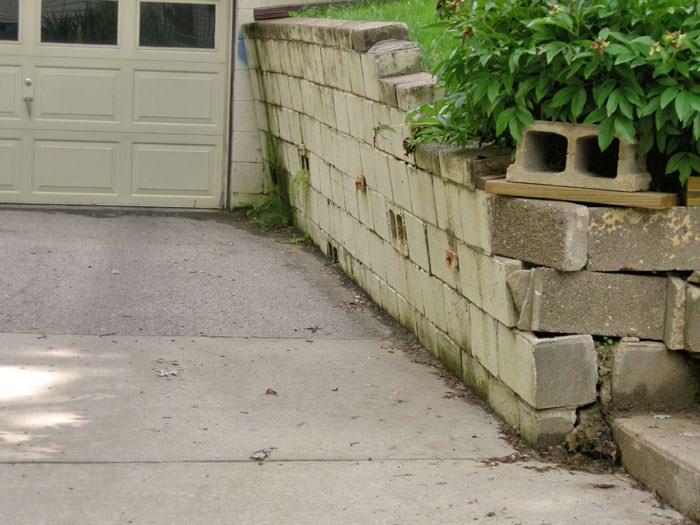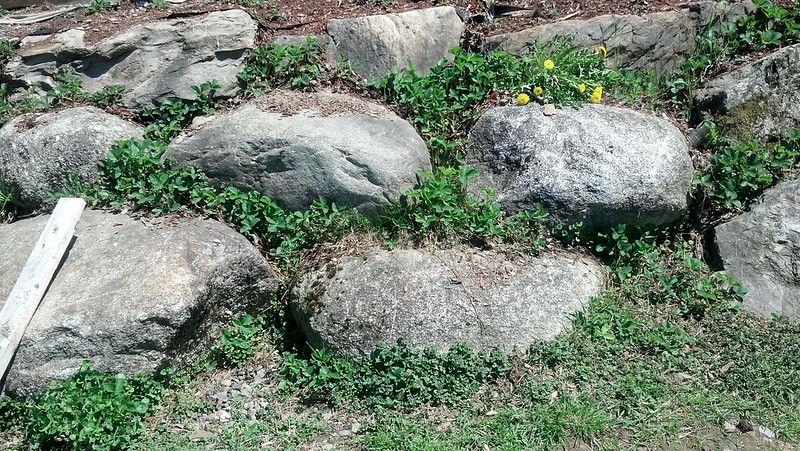6 Feb ’14
 Offline
OfflineI've been wrestling with the notion of drainage for water that infiltrates the fill within the retaining walls. Hopefully with 80% clay soil, not much will enter, but if it does, I'm concerned about it expanding the clay and increasing pressure (I will want to build strong), and about water becoming trapped at the bottom by the concrete slab.
I viewed several digrams of draining water from fill behind a retaining wall. They all used gravity and piped it out the lower portion of the wall. Some had a slope they could drain to, and the rest drained to a sump well with a pump.
Those won't work for this, especially not with water outside both retaining walls. I'd be letting water in rather than draining it.
So then I had the idea, what if I laid the slab over gravel bedding and the slab had lots of drain holes for the water to escape to the gravel bedding below? The only problem I can think of is that with clay soil under the gravel bedding, that over time the soil will break down and become increasingly resistant to seepage over time. (The very process that happens to the bottom of a mature clay bottom pond that helps it retain water better due to a lessening of losses to seepage.)
I figured I could approach it one of two ways. Pour the slab and drill the holes once dry, or get something like bamboo tubes (biodegradable) and pour the concrete around them. Drilling risks hitting or exposing rebar/remesh, and with bamboo tubes sticking out, I don't know how to finish the surface with them in the way. (The bamboo tubes could be cut down and centers drilled once dry.)
Thoughts?
earthenstead said
I just had another thought. If I'm doing form work, rebar, remesh, and ready mix concrete, what if I did my own culverts and direct the money I'd spend on precast into that? Also, I wonder how much it would cost to pour steel reinforced ready mix concrete retaining walls vs cinder blocks?
Does it count as monolithic if done in multiple pours/drys/stages? As in slab first, then culverts, then retaining walls?
I would be concerned with that, seems like there would be a ton of cold joints that could cause you problems
earthenstead said
I've been wrestling with the notion of drainage for water that infiltrates the fill within the retaining walls. Hopefully with 80% clay soil, not much will enter, but if it does, I'm concerned about it expanding the clay and increasing pressure (I will want to build strong), and about water becoming trapped at the bottom by the concrete slab.
I viewed several digrams of draining water from fill behind a retaining wall. They all used gravity and piped it out the lower portion of the wall. Some had a slope they could drain to, and the rest drained to a sump well with a pump.
Those won't work for this, especially not with water outside both retaining walls. I'd be letting water in rather than draining it.
So then I had the idea, what if I laid the slab over gravel bedding and the slab had lots of drain holes for the water to escape to the gravel bedding below? The only problem I can think of is that with clay soil under the gravel bedding, that over time the soil will break down and become increasingly resistant to seepage over time. (The very process that happens to the bottom of a mature clay bottom pond that helps it retain water better due to a lessening of losses to seepage.)
I figured I could approach it one of two ways. Pour the slab and drill the holes once dry, or get something like bamboo tubes (biodegradable) and pour the concrete around them. Drilling risks hitting or exposing rebar/remesh, and with bamboo tubes sticking out, I don't know how to finish the surface with them in the way. (The bamboo tubes could be cut down and centers drilled once dry.)
Thoughts?
yeah, I've been thinking about the drainage issue with your clay, I don't know about using block for this, I think it will just cause headaches for you down the road and will be a constant cause for concern, looking through some of the links you posted, I think the cheapest and best option would be to use stone

up here we can get 18 yards of basketball sized stone delivered for about 200 bucks, when you go bigger it's cheaper, but then you need a operator to move them
I think a stone wall with a decent back slope with textile fabric and good fill is the way to go
6 Feb ’14
 Offline
OfflineKVR said
yeah, I've been thinking about the drainage issue with your clay, I don't know about using block for this, I think it will just cause headaches for you down the road and will be a constant cause for concern
Could you explain further about the sorts of problems that you think block would create? Scenarios, links to something that explains and/or illustrates? Specifics?
I ask, because I'm in the dark here. I was thinking block could be a good option and am not thinking of any problems beyond those I've already listed.
KVR said
up here we can get 18 yards of basketball sized stone delivered for about 200 bucks
200 delivered?? As in it covers the cost of the stone and the delivery? What kind and what shape(You just answered this.) of stone?
Here, most of the quarries do not deliver. The one which does wants too much money for delivery. One quarry helped with referral to some (dump) trucking companies. The best of those quoted delivery from any of the quarries to my property for $125 per truckload. That does not include material cost.
earthenstead said
KVR said
yeah, I've been thinking about the drainage issue with your clay, I don't know about using block for this, I think it will just cause headaches for you down the road and will be a constant cause for concern
Could you explain further about the sorts of problems that you think block would create? Scenarios, links to something that explains and/or illustrates? Specifics?
I ask, because I'm in the dark here. I was thinking block could be a good option and am not thinking of any problems beyond those I've already listed.
KVR said
up here we can get 18 yards of basketball sized stone delivered for about 200 bucks
200 delivered?? As in it covers the cost of the stone and the delivery? What kind
and what shape(You just answered this.) of stone?
Here, most of the quarries do not deliver. The one which does wants too much money for delivery. One quarry helped with referral to some (dump) trucking companies. The best of those quoted delivery from any of the quarries to my property for $125 per truckload. That does not include material cost.
Just seen way to many examples of block retaining walls that have failed over the years,

repairs are pretty difficult with them as well, but it all comes down to how you build it and the look you're going for.
Yes, the 200 includes delivery and material
Most Users Ever Online: 698
Currently Online:
40 Guest(s)
Currently Browsing this Page:
1 Guest(s)
Top Posters:
easytapper: 2149
DangerDuke: 2030
groinkick: 1667
PorkChopsMmm: 1515
Gravel Road: 1455
Newest Members:
amandavvx48
kazuko52x65230
dennisjaffe1
chancenaranjo08
lorrihausmann8
Forum Stats:
Groups: 1
Forums: 12
Topics: 11479
Posts: 58674
Member Stats:
Guest Posters: 2
Members: 3594
Moderators: 0
Admins: 1
Administrators: K

 Register
Register Log In
Log In Home
Home










